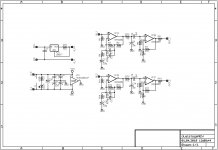Hi all,
I have designed (filter circuit is inspired from an internet project that I already forgot) that about one year ago. However couldn't find any chance to make it until now.
It's a mixed filter stage (passive+NFB) and battery powered (4.8v) MM type preamp. in the simulation its RIAA curve accordance in 20Hz-20KHz band is +/- 0.05dB max with 1% resistors and 5% capacitors. I have already purchased 0.1% resistors and 1%capacitors (all MKP except 220µ) from Farnell. So I am expecting better results.
Since its battery powered I am using a virtual ground circuit that provided by a TLE2426. Its actual gain is ~41dB (@1Khz). It has capability to upgrade for MC heads with a simple resistor changing. The opamp (OPA4353) I use is an audio grade BB CMOS opamp since its rail to rail and low power one.
LM317 stage is just for battery charging nothing about the circuit.
So may you share your advices about my RIAA preamp please..
Thanks in advance for anykind of comment or recommendation..
I have designed (filter circuit is inspired from an internet project that I already forgot) that about one year ago. However couldn't find any chance to make it until now.
It's a mixed filter stage (passive+NFB) and battery powered (4.8v) MM type preamp. in the simulation its RIAA curve accordance in 20Hz-20KHz band is +/- 0.05dB max with 1% resistors and 5% capacitors. I have already purchased 0.1% resistors and 1%capacitors (all MKP except 220µ) from Farnell. So I am expecting better results.
Since its battery powered I am using a virtual ground circuit that provided by a TLE2426. Its actual gain is ~41dB (@1Khz). It has capability to upgrade for MC heads with a simple resistor changing. The opamp (OPA4353) I use is an audio grade BB CMOS opamp since its rail to rail and low power one.
LM317 stage is just for battery charging nothing about the circuit.
So may you share your advices about my RIAA preamp please..
Thanks in advance for anykind of comment or recommendation..
Attachments
5% tolerance capacitors implies +/- 0.5 dB RIAA accuracy, your 0.05 dB figure is calculated for the components as exactly the stated value.
The circuit itself is straightforward and reliable... except for the headroom issue brought up previously. If your want the simplicity of running from a low voltage battery an all active RIAA filter would be a better option.
The circuit itself is straightforward and reliable... except for the headroom issue brought up previously. If your want the simplicity of running from a low voltage battery an all active RIAA filter would be a better option.
Thanks for the advices..
Concerning the PSU headroom issue;
USB-Powered High Precision Hi-Fi Phono Preamp - Maxim
What do you think about that? My op-amp specs are very similar to MAX4478.. So I am expecting no hearable distortion even with 3,6v suppy!
And what do you think about the TLE2426? Is it enoughly noise free for that position do you think?
Concerning the PSU headroom issue;
USB-Powered High Precision Hi-Fi Phono Preamp - Maxim
What do you think about that? My op-amp specs are very similar to MAX4478.. So I am expecting no hearable distortion even with 3,6v suppy!
And what do you think about the TLE2426? Is it enoughly noise free for that position do you think?
Fantastic. Fed from 3.3 Volts...What do you think about that?
"High Precision" for those guys is something completely different from what it is for us audio people. That circuit is intended to be used in "50$ special offer USB out" turntables. Quality isn't the biggest issue there.
Right.. But if you take a look my filter design and opamp specs then you'll see my pre will be a really precision RIAA opamp!
I cannot see any reason that a "rail to rail low distortion and low noise" opamp will not give good results with that level of supply voltage! Which is really comparable with LM4562, OPA604, OPA134, AD797 type popular opamps..
I cannot see any reason that a "rail to rail low distortion and low noise" opamp will not give good results with that level of supply voltage! Which is really comparable with LM4562, OPA604, OPA134, AD797 type popular opamps..
Ozgur,
Precisely following the anti-RIAA curve is one thing. The final sound quality is determined by many other factors, starting from the choice of the gain element (opamp and type thereof, BJT, FET, tube), topology (feedback or passive equalization), power supply (3-legs, discrete, battery) etc. I also built a phono similar to yours. It was technically "perfect" but sonically inferior.
Precisely following the anti-RIAA curve is one thing. The final sound quality is determined by many other factors, starting from the choice of the gain element (opamp and type thereof, BJT, FET, tube), topology (feedback or passive equalization), power supply (3-legs, discrete, battery) etc. I also built a phono similar to yours. It was technically "perfect" but sonically inferior.
I am absolutely aggree with you..
My components arrived just this morning.. I guess I will finish the project by this weekend and hear the results next week.
My filter topology, component selection and psu (which is only battery) is best I can do. I hope the results will the best also
I'll inform you about the impressions next week.
Thanks for the sharing.
My components arrived just this morning.. I guess I will finish the project by this weekend and hear the results next week.
My filter topology, component selection and psu (which is only battery) is best I can do. I hope the results will the best also
I'll inform you about the impressions next week.
Thanks for the sharing.
- Status
- This old topic is closed. If you want to reopen this topic, contact a moderator using the "Report Post" button.
- Home
- Source & Line
- Analogue Source
- Precision op-amp RIAA pre..
